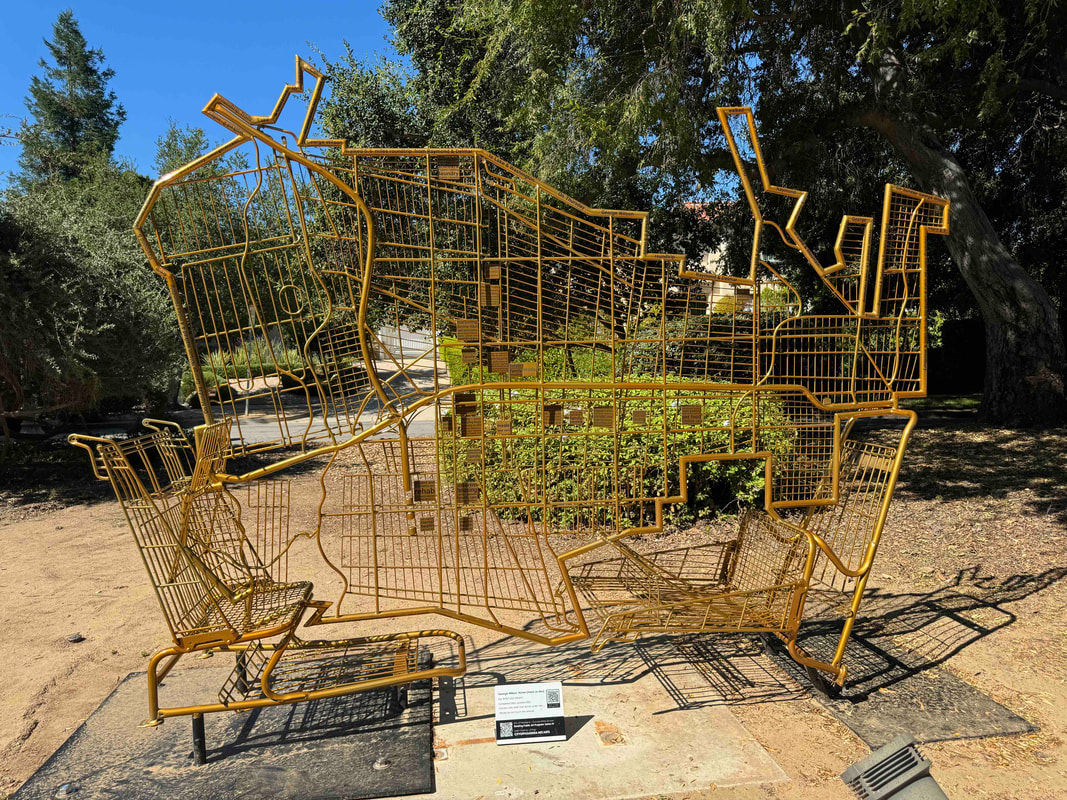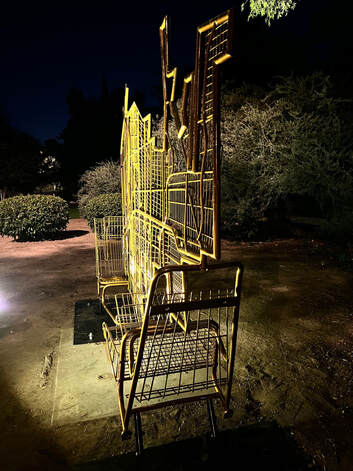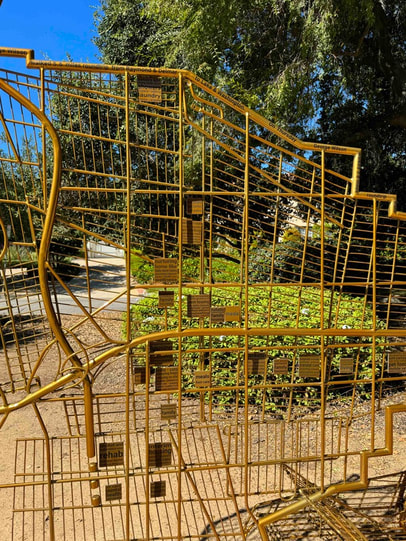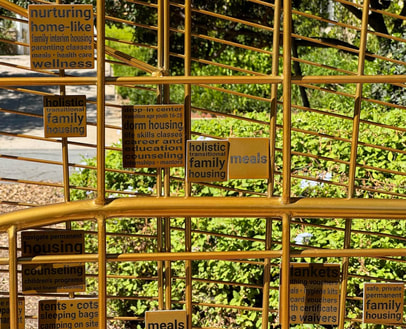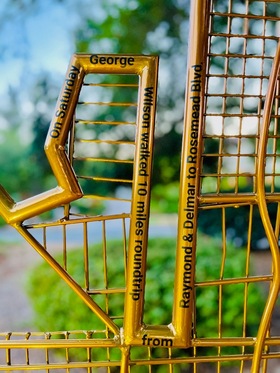George Wilson: Home (more-or-less)
|
2003. Updated 2015 and 2023.
Dimensions: 10’6 W x 7’6 H x 3’ D. Materials: Four steel grocery carts, steel rods, aluminum plates, hardware, adhesive, powder coating, vinyl decals, and QR code with audio clips. Welding: Len Ricci. Currently on view at Sidney F. Tyler Park, on S. Lake Avenue at Oakwood Place, Pasadena, CA, as part of the Pasadena Rotating Public Art Program Phase IV. |
Audio Clips:Below are eight short clips from a recorded interview the artist conducted with George Wilson, with his permission, at Union Station Homeless Services, Pasadena, CA in 2002.
|
Description:George Wilson: HOME (more-or-less) is a multi-media sculpture exploring the subject of homelessness in Pasadena, California. The sculpture is composed of steel shopping carts cut and welded into an approximate map of Pasadena. Grocery carts have long been used by – and associated with – people who are experiencing homelessness and living on the streets. Grocery carts can be a useful means of storing and transporting personal possessions for people shuffling from one temporary encampment to another. At the same time, grocery carts are also used and appreciated by anyone shopping at a grocery store. It's only when we encounter them outside of the parking lot that we realize a different purpose and how they symbolize the nomadic lifestyle of the unhoused.
This sculpture, painted gold to signify great value, includes labels that identify existing resources within Pasadena's City limits for the unhoused, such as interim and permanent housing for individuals and families, meals, showers, laundry, clothing, physical and mental health care, alcohol and substance therapy, counseling, career services, safe parking, safe camping, and more. (See below for a list and links.) The labels are placed at the approximate locations on the map where these basic essential services can be found.*
The title of the sculpture refers to an unhoused man named George Wilson who Lisa Mann met and interviewed in 2002 at Union Station Homeless Services. In addition to the interview, Mr. Wilson agreed to wear an odometer to log his daily mileage while walking and pushing his cart around Pasadena for one week. The text follows along the perimeter of the map, which is Pasadena's border.
The audio component of the sculpture consists of excerpts from the interview with Mr. Wilson. At the time, he had been living and surviving on the streets of Pasadena for several years. In the interview, Mr. Wilson reflects on the life events which lead to his situation, his street survival techniques, and his philosophy. His words challenge several stereotypical myths associated with homelessness and shine a light on how we continue to fail the unhoused in this country.
The art work was partially funded by an Individual Artist Grant from the City of Pasadena Cultural Affairs in 2002, and originally installed in the group exhibition "Outdoor Sculpture Installational" at the Armory Center Northwest, in Pasadena. In 2015, it was included in “Feed the Weed,” the NewTown Foundation exhibition in Pasadena, CA.
*In 2023, the map was refurbished and powder coated, and the labels were updated to reflect current services offered within the city of Pasadena. The original CD player was replaced with a QR code linking to this webpage with the audio clips.
|
Review:
By far the most touching piece in the show – and the most persuasive in its convictions – is Lisa Mann's "George Wilson: Home (more-or-less)" (2003), a sculpture that combines the elements of two shopping carts into a free-standing street map of Pasadena, on which are designated various locations important in the life of George Wilson, a homeless man whom Mann interviewed: "meals," "shelter," "shower," recycling center," and so on. The structure is painted gold (to signify importance, Mann notes) and emits an absorbing audio recording of Wilson discussing his life.
The work is less a political statement than homage to Wilson – in whom, judging from the recording, there is much to admire – and it's accomplished with great sensitivity and respect.... In genuinely engaging with the world, peering into a space we often willfully overlook and then re-presenting that space in a form we can understand, Mann surely accomplishes a great deal."
From "Empty Lot, Blank Canvas" (L.A. Times, August 14, 2003), by Holly Myers, a review of the Armory Northwest show, "Outdoor Sculptural Installational."

